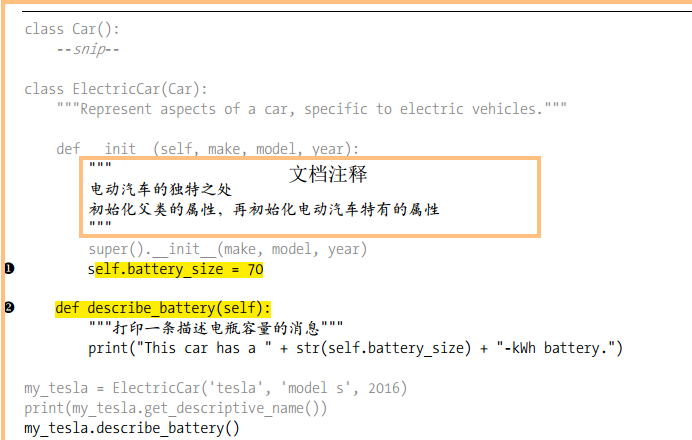如果你要编写的类是另一个现成类的特殊版本,可使用继承。一个类继承另一个类时,它将自动获得另一个类的所有属性和方法;原有的类称为父类,而新类称为子类。子类继承了其父类的所有属性和方法,同时还可以定义自己的属性和方法。
## 9.3.1 子类的方法_init_()
创建子类的实例时, Python首先需要完成的任务是给父类的所有属性赋值。为此,子类的方法_init_()需要父类施以援手。
```
from car import Car
#Car是父类,ElectricCar是子类
class ElectricCar(Car):
初始化子类实例,需要先对父类属性赋值
def __init__(self, manufacturer, model, year):
super().__init__(manufacturer, model, year)
self.battery = Battery()
```
创建子类时,父类必须包含在当前文件中,且位于子类前面。
定义子类时,必须在括号内指定父类的名称。
## 9.3.3 给子类定义属性和方法
添加battery_size属性和describe_battery(self)方法

## 9.3.4 重写父类的fill_gas_tank()方法
在子类中定义一个这样的方法,即它与要重写的父类方法同名。这样, Python将不会考虑这个父类方法,而只关注你在子类中定义的相应方法。
假设Car类有一个名为fill_gas_tank()的方法,它对全电动汽车来说毫无意义,因此你可能想重写它。下面演示了一种重写方式:

## 9.3.5 将实例用作属性
不断给ElectricCar类添加细节时,我们可能会发现其中包含很多专门针对汽车电瓶
的属性和方法。在这种情况下,我们可将这些属性和方法提取出来,放到另一个名为Battery的类中,并将一个Battery实例用作ElectricCar类的一个属性:
```
from car import Car
class Battery():
"""A simple attempt to model a battery for an electric car."""
def __init__(self, battery_size=60):
"""Initialize the batteery's attributes."""
self.battery_size = battery_size
def describe_battery(self):
"""Print a statement describing the battery size."""
print("This car has a " + str(self.battery_size) + "-kWh battery.")
def get_range(self):
"""Print a statement about the range this battery provides."""
if self.battery_size == 60:
range = 140
elif self.battery_size == 85:
range = 185
message = "This car can go approximately " + str(range)
message += " miles on a full charge."
print(message)
class ElectricCar(Car):
"""Models aspects of a car, specific to electric vehicles."""
def __init__(self, manufacturer, model, year):
super().__init__(manufacturer, model, year)
self.battery = Battery()
```
